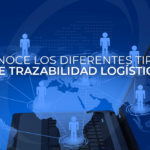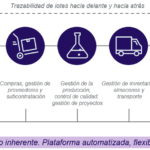
¿Qué es la trazabilidad en inglés?
🔍 La trazabilidad en inglés se traduce como «traceability». Es una palabra que se utiliza para describir la capacidad de rastrear un producto o un proceso desde su origen hasta su destino final. En el ámbito empresarial, la trazabilidad es fundamental para garantizar la calidad y la seguridad de los productos, así como para cumplir con los requisitos legales y las normativas vigentes.
📋 La trazabilidad implica el registro y seguimiento de toda la información relevante relacionada con la cadena de suministro de un producto. Esto incluye datos como la procedencia de las materias primas utilizadas, los proveedores involucrados, los diferentes procesos de fabricación y distribución, así como las fechas de producción y envasado.
✅ La trazabilidad es especialmente importante en sectores como la industria alimentaria y farmacéutica, donde la seguridad y la calidad son fundamentales. Permite identificar rápidamente cualquier problema o incidencia que pueda surgir durante el proceso de producción o distribución, lo que facilita la toma de decisiones y minimiza los riesgos para los consumidores.
🌐 La trazabilidad también es esencial en el comercio internacional, ya que ayuda a asegurar el cumplimiento de los estándares de calidad y seguridad en los productos importados y exportados. Además, la trazabilidad puede ser una herramienta muy valiosa para mejorar la eficiencia y la gestión de la cadena de suministro de una empresa, permitiendo identificar posibles áreas de mejora y optimizar los procesos.
🔑 En resumen, la trazabilidad en inglés es el concepto de «traceability» y se refiere a la capacidad de rastrear un producto o un proceso desde su inicio hasta su fin. Es fundamental para garantizar la calidad y la seguridad de los productos, cumplir con los requisitos legales y las normativas, así como para mejorar la eficiencia y la gestión en la cadena de suministro. ¡No subestimes el poder de la trazabilidad en el mundo empresarial actual!
Beneficios de la trazabilidad en inglés en la industria
🔍 La trazabilidad en la industria es un elemento clave para garantizar la calidad y seguridad de los productos. Esta práctica consiste en el seguimiento y documentación detallada de cada etapa de producción y distribución, desde el origen de la materia prima hasta el consumidor final.
🚚 Uno de los principales beneficios de implementar la trazabilidad en inglés es la capacidad de rastrear rápidamente cualquier problema o incidencia en la cadena de suministro. Esto permite una respuesta ágil frente a situaciones como retiros de productos o alertas de seguridad, minimizando el impacto en la reputación de la empresa y manteniendo la confianza de los consumidores.
✅ Además, la trazabilidad en inglés facilita la identificación de posibles mejoras en los procesos productivos. Al contar con datos precisos sobre la procedencia de los insumos, es posible identificar tendencias, evaluar la eficiencia de proveedores y detectar oportunidades de optimización, lo que se traduce en una mayor rentabilidad para la compañía.
🌍 Otro beneficio importante es el cumplimiento de normativas y regulaciones internacionales. La trazabilidad en inglés permite a las empresas demostrar el origen y calidad de sus productos en mercados extranjeros, facilitando la exportación y abriendo nuevas oportunidades de negocio.
🔒 Por último, la trazabilidad en inglés es fundamental en la industria alimentaria para garantizar la seguridad de los consumidores. En caso de alertas sanitarias o brotes de enfermedades, contar con información precisa sobre la procedencia de los alimentos permite identificar y retirar rápidamente los productos afectados, evitando riesgos para la salud pública.
Estos son solo algunos ejemplos de los beneficios que la trazabilidad en inglés aporta a la industria. Implementar esta práctica no solo es una excelente estrategia de gestión, sino también una forma de ofrecer productos de calidad y seguros para los consumidores. 🌟
- 🌳🔍 Descubre la importancia de la www trazabilidad forestal en nuestra sociedad
- 🔍💡 Todo lo que necesitas saber sobre la 🔎trazabilidad COVID: ¿Cómo funciona y por qué es importante?
- 🔍✨ Descubre la importancia de la trazabilidad de las muestras: ¡Asegura la calidad en tu laboratorio!
- 🐮✅ La importancia de la trazabilidad ganadería: ¿Cóm
- 🔎📦 Trazabilidad Obligatoria: Todo lo que necesitas saber para cumplir con los requisitos 📋🔍
Cómo implementar la trazabilidad en inglés
🔎 Implementing traceability in English is crucial for businesses operating in global markets. With traceability, companies can track the movement of products and ensure their safety and quality throughout the supply chain. In this post, we will explore the key steps and best practices to implement traceability in English-speaking environments.
📋 The first step in implementing traceability is to define a clear and comprehensive traceability plan. This plan should outline the goals of traceability, the processes and technologies to be used, and the responsibilities of each stakeholder involved. By establishing a solid plan, businesses can effectively manage and monitor their supply chain operations.
🔗 Once the traceability plan is in place, the next step is to choose the appropriate traceability technologies. There are various technologies available, such as barcodes and RFID tags, that enable the identification and tracking of products. Businesses should select technologies that align with their specific needs and ensure compatibility with English-speaking systems and standards.
🔄 The implementation of traceability requires collaboration and communication across the entire supply chain. It is important to establish strong partnerships with suppliers, manufacturers, and distributors to ensure seamless information exchange. By implementing traceability in English, businesses can enhance transparency and build trust with their international partners.
Implementing traceability in English is essential for companies looking to expand their global presence. By following the steps outlined in this post and leveraging appropriate technologies, businesses can achieve greater visibility and control over their supply chain operations. Stay tuned for more insights on traceability and its benefits in future posts.✨
Las mejores prácticas para garantizar la trazabilidad en inglés
🔍✅ The Best Practices for Ensuring Traceability in English
The implementation of effective traceability measures is crucial in various industries, especially those that rely heavily on supply chains. Traceability not only ensures product quality but also helps in identifying and resolving issues or recalls efficiently. In this article, we will explore the best practices for guaranteeing traceability in English.
⭐ Implement a comprehensive identification system: To ensure proper traceability, it is vital to have a robust identification system in place. This includes assigning unique identifiers or serial numbers to products or components, which can be easily tracked throughout the supply chain. Utilizing standardized barcode or RFID technology can simplify the monitoring process.
⭐ Maintain accurate records: Accurate and up-to-date record keeping is essential for traceability. It is important to maintain a centralized database or system that records information about each product’s origin, production process, and movement through the supply chain. This data should be easily accessible and protected to ensure its integrity.
⭐ Establish traceability at each stage of the supply chain: Traceability should not be limited to a single point in the supply chain. Instead, it should be incorporated at each stage, from raw material sourcing to manufacturing, distribution, and even post-sales activities. This helps in identifying any potential bottlenecks or issues that may arise during the product lifecycle.
⭐ Implement traceability audits: Regular audits are crucial for validating the effectiveness of traceability systems. These audits should verify the accuracy and reliability of the recorded data, as well as the implementation of traceability practices throughout the supply chain. Conducting internal or external audits helps in identifying gaps or areas that need improvement.
⭐ Collaborate with suppliers and stakeholders: Ensuring traceability requires collaboration with suppliers, manufacturers, distributors, and other stakeholders. It is important to establish clear communication channels and agreements regarding traceability requirements and expectations. This collaboration helps in maintaining transparency and accountability throughout the supply chain.
Implementing the best practices mentioned above can significantly enhance traceability efforts, leading to better quality control, customer satisfaction, and streamlined operations. Remember, traceability is not just a legal or regulatory requirement, but a crucial aspect of building trust and credibility in today’s global marketplace. Stay tuned for more insights on traceability and its impact on various industries! ✨
Desafíos de la trazabilidad en inglés y cómo superarlos
🔍⚙️
The challenges of traceability in English and how to overcome them are crucial aspects to consider in today’s globalized world.🌍 Traceability refers to the ability to track and trace the movement of products throughout the supply chain, ensuring transparency and accountability. However, when it comes to implementing traceability systems in an English-speaking context, several challenges arise.
One of the main challenges is language barriers. English is the universal language of business, but not all stakeholders involved in the supply chain may have a strong command of the language. This can lead to miscommunication and errors in data exchange, hindering the effectiveness of traceability efforts. To overcome this challenge, it is essential to provide multilingual support and clear communication channels to ensure effective collaboration and understanding.
Another challenge is the complexity of data management. Traceability systems generate large volumes of data, including product details, logistics information, and quality control records. Managing this data effectively can be overwhelming, especially when dealing with multiple stakeholders and diverse systems. Implementing standardized data formats and using appropriate data management tools and software can help streamline the process and ensure accurate and accessible information.
Furthermore, technological limitations pose a significant challenge in traceability. The adoption of modern technologies such as RFID tags and barcodes enables efficient data collection and tracking. However, not all stakeholders may have the necessary infrastructure or resources to implement these technologies. Overcoming this challenge requires collaborative efforts, where stakeholders can share resources and knowledge to ensure the successful implementation of traceability systems.
In conclusion, the challenges of traceability in an English-speaking context can be conquered through clear communication channels, effective data management, and collaborative efforts. By addressing language barriers, managing data efficiently, and embracing technology, businesses can enhance transparency, improve accountability, and build trust within the supply chain. Ultimately, overcoming these challenges leads to a more sustainable and responsible approach to global trade and ensures the overall success of traceability initiatives.
 🔍✨ Descubre la guía completa de trazabilidad informática: cómo garantizar un seguimiento efectivo en tu negocio 🖥️✅
🔍✨ Descubre la guía completa de trazabilidad informática: cómo garantizar un seguimiento efectivo en tu negocio 🖥️✅ 🔍✈️ Descubre la increíble trazabilidad interrapidisimo y optimiza tu logística
🔍✈️ Descubre la increíble trazabilidad interrapidisimo y optimiza tu logística 🔍💡 Descubre cómo alcanzar la trazabilidad 🚚🔐 inacal, ¡una estrategia esencial para tu negocio!
🔍💡 Descubre cómo alcanzar la trazabilidad 🚚🔐 inacal, ¡una estrategia esencial para tu negocio! 🔍✨ Descubre la importancia de la trazabilidad en la industria de las joyas
🔍✨ Descubre la importancia de la trazabilidad en la industria de las joyas 🔍🔐💼 Trazabilidad Poder Judicial: Descubre cómo garantizar la transparencia en el sistema legal
🔍🔐💼 Trazabilidad Poder Judicial: Descubre cómo garantizar la transparencia en el sistema legal 🔍📚 Diccionario Jurídico de Trazabilidad: Conoce los Conceptos Clave 🕵️♂️
🔍📚 Diccionario Jurídico de Trazabilidad: Conoce los Conceptos Clave 🕵️♂️ 🔎🔍 Trazabilidad Logytech: La clave para optimizar la gestión de tu cadena de suministro
🔎🔍 Trazabilidad Logytech: La clave para optimizar la gestión de tu cadena de suministro 🔍✨ ¡Descubre la trazabilidad de la LOMLOE! Todo lo que necesitas saber 📚💡
🔍✨ ¡Descubre la trazabilidad de la LOMLOE! Todo lo que necesitas saber 📚💡 🔍💡 La Trazabilidad en La Pampa: ¡Descubre cómo esta herramienta revoluciona la industria!
🔍💡 La Trazabilidad en La Pampa: ¡Descubre cómo esta herramienta revoluciona la industria!